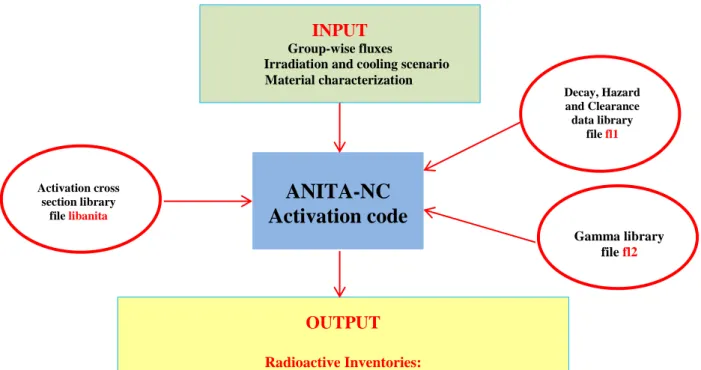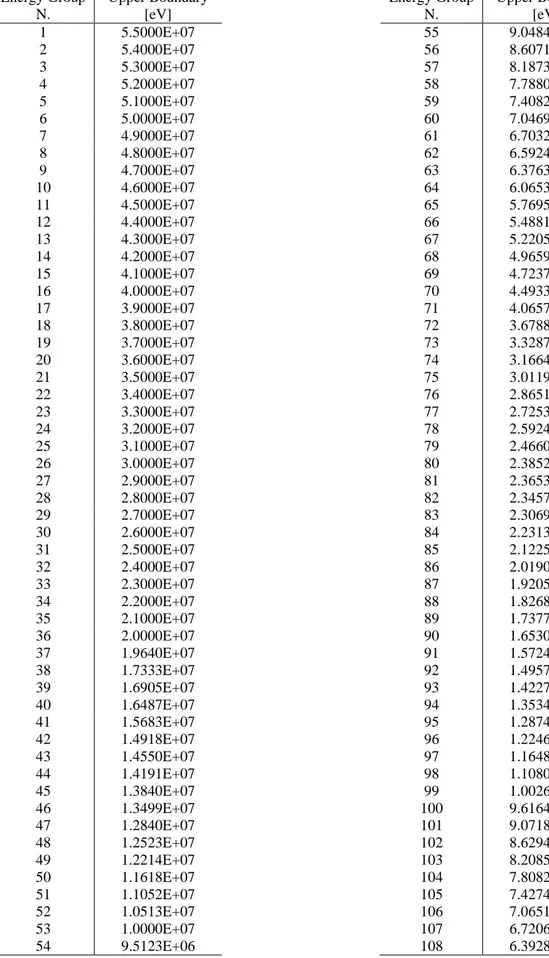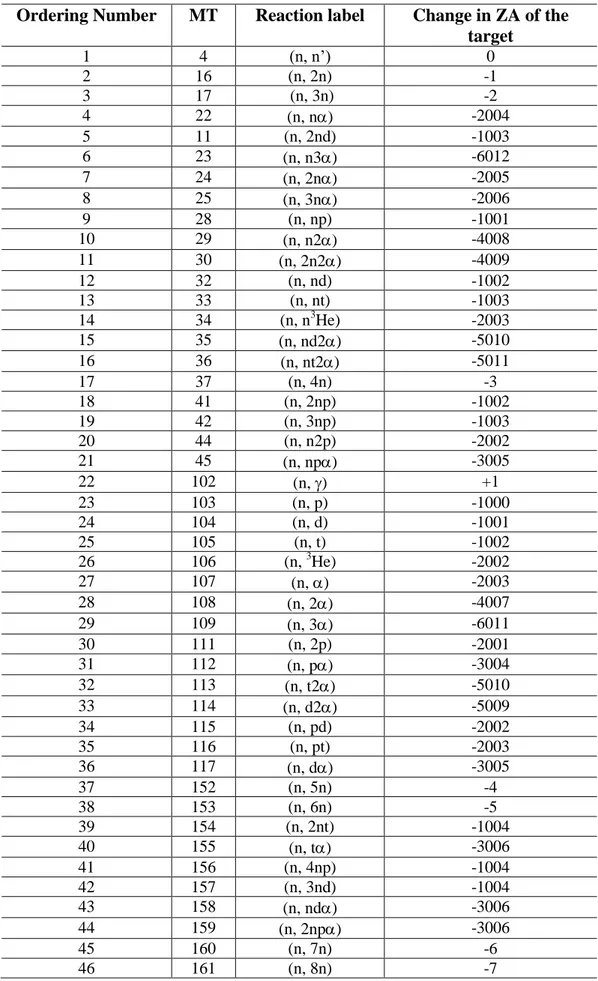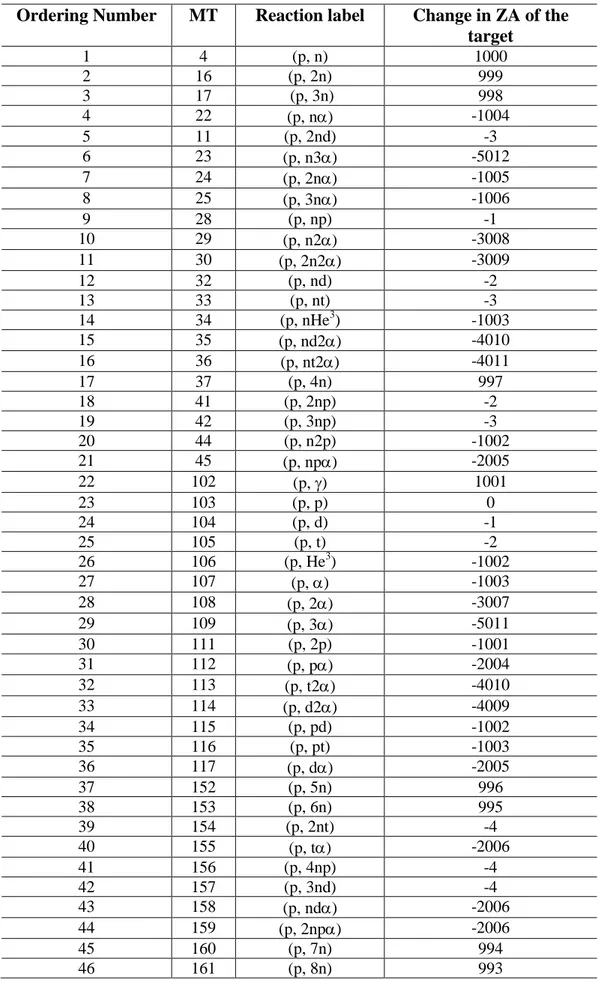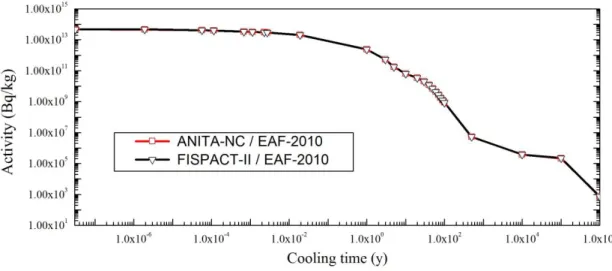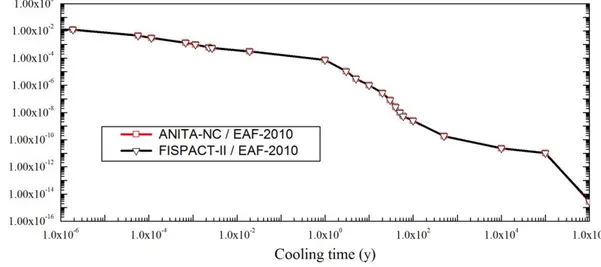CONTENTS
1 INTRODUCTION ... 5
2 DATA LIBRARIES ... 7
2.1 Decay, Hazard and Clearance Data library (file “fl1”) ... 8
2.2 Gamma Library (file “fl2”) ... 8
2.3 Activation cross section data library (file “libanita”) ... 10
3 SAMPLE PROBLEMS ... 19
3.1 Deuteron activation ... 19
3.2 Proton activation ... 22
4 CONCLUSION ... 23
FIGURE LIST
Figure 1 – ANITA-NC activation code block diagram ... 7
Figure 2 – Deuteron induced activity on Titanium vs. cooling time. ... 21
Figure 3 – Deuteron induced decay heat on Titanium vs. cooling time ... 21
Figure 4 – Proton induced activity on Copper vs. cooling time. ... 22
TABLE LIST
Table 1 – Upper boundaries of the Vitamin-J 42- energy group structure ... 9
Table 2 – Energy group boundaries of the Vitamin-J +(211-neutron energy group structure) ... 11
Table 3 – List of MT numbers (neutron induced reactions) used in ANITA-NC package ... 13
Table 4 – List of MT numbers (proton induced reactions) used in ANITA-NC package ... 15
Table 5 – List of MT numbers (deuteron induced reactions) used in ANITA-NC package ... 17
Table 6 – FISPACT-II input file... 19
Production of the ANITA-NC system able to treat material activation due
to neutral or charged particles
Manuela Frisoni November 2018
1 INTRODUCTION
ANITA-NC is a package (code and libraries), developed in ENEA-Bologna, able to assess the activation of materials exposed both to neutrons and charged particles. It is an updating/extension of previous ANITA versions as ANITA-2000, able to handle neutrons with energies up to 20 MeV, widely used and validated in the past by ENEA [1][2][3][4][5][6] and ANITA-IEAF, able to treat neutrons with energies up to 55 MeV, actually in free distribution at OECD-NEADB with the identification NEA-1638 [7][8].
The ANITA-NC package is needed in order to perform neutron activation calculations for some facilities as the International Fusion Materials Irradiation Facility (IFMIF) and, more recently, the DEMO Oriented Neutron Source (DONES), that have been proposed as neutron sources to test samples of candidate materials to be used in future fusion power plants. In both these facilities the neutron source is produced through the reaction of 40 MeV deuterons impinging on a liquid lithium target and a considerable amount of neutrons with energies above 20 MeV is produced.
In these devices the deuterons can themselves cause activation, particularly in the accelerator structure and in the lithium target. So, in these facilities the capability to perform deuteron activation calculations is also required.
The main component of the ANITA-NC system is the activation code ANITA-NC able to compute the radioactive inventory of a material exposed to n, p, d, α and γ irradiation, continuous or stepwise. It traces back to the ANITA code (Analysis of Neutron Induced Transmutation and Activation) [9][10].
The ANITA-NC code provides activity, atomic density, decay heat, biological hazard, clearance index and decay gamma-ray sources versus cooling time. Results are given as for each nuclide as for the material.
The ANITA-NC code package requires the following files/libraries in order to perform the activation calculations:
3) Gamma library (file “fl2”), containing the gamma ray spectra emitted by the radioactive nuclei.
ANITA-NC reads multi-group activation cross section libraries in the LIBOUT format of the FOUR ACES code (ENEA Bologna). The only available libraries in this format are the EAF libraries produced for the EASY activation systems. In particular, ANITA-NC uses the EAF-2010 activation cross libraries contained in the original EASY-2010 code package [11], actually included in the FISPACT-II Release 4.0 system [12] in free distribution at NEA Data Bank (NEA- 1890). These libraries contain cross sections for neutrons, deuterons and protons only. ANITA-NC uses a neutron activation cross section data library based on the EAF-2010 group-wise library “eaf_n_gxs_211_flt_20010” in the VITAMIN-J+ (211 energy group structure) up to 55 MeV. For deuterons and protons it uses libraries based on the corresponding EAF-2010 libraries, “eaf_d_gxs_211_flt_20010” and “eaf_p_gxs_211_flt_20010” in the same VITAMIN-J+ (211 energy group structure) up to 55 MeV.
So, although ANITA-MC is structured in order to perform also the activation of materials induced by alpha particles and photons, actually, for these projectiles, activation libraries in the format required by ANITA-NC are not available.
The data contained in the fl1 and fl2 files are based on the JEFF-3.1.1 Radioactive Decay Data Library [13].
In this report a brief description of the characteristics of the code and the libraries contained in the package is given.
Two sample problems, related to deuteron and proton activation, are also presented. The ANITA-NC results are compared with the FISPACT-II corresponding ones.
2 DATA LIBRARIES
The ANITA-NC activation code requires the following data libraries: Decay, Hazard and Clearance data library (file “fl1”)
Gamma library (file “fl2”)
Neutron, deuteron and proton activation cross section data library (file “libanita”)
The schematic block diagram of the data/libraries required by the ANITA-NC code is shown in Figure 1.
Figure 1 – ANITA-NC activation code block diagram
ANITA-NC
Activation code
INPUT Group-wise fluxes
Irradiation and cooling scenario Material characterization
OUTPUT
Radioactive Inventories:
activity, atomic density, decay heat, biological hazard, clearance index, decay gamma sources (42 groups) at shutdown and for various cooling times.
Results are given as for each nuclide as for the material
Gamma library file fl2 Activation cross section library file libanita Decay, Hazard and Clearance data library file fl1
2.1 Decay, Hazard and Clearance Data library (file “fl1”)
This library contains the information describing the decay properties of unstable nuclides useful for the calculations performed by ANITA-NC.
For each nuclide, the decay data, as the decay mode, the decay constant (s-1), the total energy (MeV) released in the decay and the energy (MeV) released in the form of gamma or X-rays are provided. Different competitive decay modes are taken into account when contemporary.
The file contains also the hazard data (ALI) for each radionuclide describing its potential biological impact on human beings. The ALI quantities are defined as the Annual Limit of Intake (Bq) by ingestion or inhalation for the public or workers.
The library contains also the clearance level for each radionuclide. The fl1 file contains data for 3433 nuclides.
2.2 Gamma Library (file “fl2”)
This data base contains the gamma ray spectra emitted by the radioactive nuclei in the Vitamin-J 42- energy group structure given in Table 1.
Energy Group N. Upper Boundary [eV] 1 5.00E+07 2 3.00E+07 3 2.00E+07 4 1.40E+07 5 1.20E+07 6 1.00E+07 7 8.00E+06 8 7.50E+06 9 7.00E+06 10 6.50E+06 11 6.00E+06 12 5.50E+06 13 5.00E+06 14 4.50E+06 15 4.00E+06 16 3.50E+06 17 3.00E+06 18 2.50E+06 19 2.00E+06 20 1.66E+06 21 1.50E+06 22 1.34E+06 23 1.33E+06 24 1.00E+06 25 8.00E+05 26 7.00E+05 27 6.00E+05 28 5.12E+05 29 5.10E+05 30 4.50E+05 31 4.00E+05
32 3.00E+05 33 2.00E+05 34 1.50E+05 35 1.00E+05 36 7.50E+04 37 7.00E+04 38 6.00E+04 39 4.50E+04 40 3.00E+04 41 2.00E+04 42 1.00E+04
Table 1 – Upper boundaries of the Vitamin-J 42- energy group structure
The data contained in the library are based on the JEFF-3.1.1 evaluated decay data file (gamma radiation spectra). The data given in the gamma library are used in ANITA-NC to compute the intensity and the energy distribution of the gamma-rays emitted by the irradiated material. This gamma-ray source (photons×cm-3×s-1) in the VITAMIN-J 42- energy group structure may be given as input to a radiation transport code in order to compute the space and energy distribution of the decay gamma-rays and the relative dose equivalent rate.
2.3 Activation cross section data library (file “libanita”)
The ANITA-NC code requires a multi-group activation cross section data library in order to perform the activation calculations. A different library is needed for each incident projectile.
The format of these multi-group libraries is the LIBOUT format of the FOUR ACES code (ENEA Bologna) with two additional comment lines for each reaction. Actually, the ANITA-NC code uses activation cross section libraries based on the EAF-2010 group-wise libraries “eaf_n_gxs_211_flt_20010”, “eaf_d_gxs_211_flt_20010” and “eaf_p_gxs_211_flt_20010”, for neutrons, deuterons and protons respectively, in the VITAMIN-J+ (211 energy group structure) up to 55 MeV.
The VITAMIN-J+ (211 energy group structure) is listed in Table 2.
In the ANITA-NC code new MT numbers have been introduced, from 151 to 200, the same as in FISPACT code, that allow describing reactions with up to 8 emitted particles corresponding to a set of unallocated numbers in the standard ENDF-6 format.
In Table 3, Table 4 and Table 5 the 85 MT values used in the ANITA-NC code for n, p and d are shown, respectively. In the Tables, in column 3, for each MT, the corresponding reaction label that describes the reaction is given. Each reaction corresponds to a well-defined ZA (ZA=Z*1000+A) change with respect to the target nuclide and this Δ(ZA) is used in the activation code to create and follow the decay chains.
In the activation cross sections libraries, for the reaction numbers the ENDF-reaction number MT multiplied by 10 has been adopted, with the convention that for the excitation of each isomeric state the reaction number is increased by one. The material numbers, MAT, consist of Z, A and an identifier, LIS, to indicate ground or isomeric target (MAT=Z*10000+A*10+LIS). The order of the cross sections of the libraries is in accordance with increasing Z,A,LIS and MT. The cross section values of each reaction MT are in accordance with decreasing energy of the VITAMIN-J+ group structure.
The neutron, deuteron and proton libraries are provided in card-image format. The MODBIN module must be used for the conversion of the card image file to libanita (see Figure 1) in binary format as required by the ANITA-NC code.
Table 2 – Energy group boundaries of the Vitamin-J +(211- energy group structure) Energy Group N. Upper Boundary [eV] 1 5.5000E+07 2 5.4000E+07 3 5.3000E+07 4 5.2000E+07 5 5.1000E+07 6 5.0000E+07 7 4.9000E+07 8 4.8000E+07 9 4.7000E+07 10 4.6000E+07 11 4.5000E+07 12 4.4000E+07 13 4.3000E+07 14 4.2000E+07 15 4.1000E+07 16 4.0000E+07 17 3.9000E+07 18 3.8000E+07 19 3.7000E+07 20 3.6000E+07 21 3.5000E+07 22 3.4000E+07 23 3.3000E+07 24 3.2000E+07 25 3.1000E+07 26 3.0000E+07 27 2.9000E+07 28 2.8000E+07 29 2.7000E+07 30 2.6000E+07 31 2.5000E+07 32 2.4000E+07 33 2.3000E+07 34 2.2000E+07 35 2.1000E+07 36 2.0000E+07 37 1.9640E+07 38 1.7333E+07 39 1.6905E+07 40 1.6487E+07 41 1.5683E+07 42 1.4918E+07 43 1.4550E+07 44 1.4191E+07 45 1.3840E+07 46 1.3499E+07 47 1.2840E+07 48 1.2523E+07 49 1.2214E+07 50 1.1618E+07 51 1.1052E+07 Energy Group N. Upper Boundary [eV] 55 9.0484E+06 56 8.6071E+06 57 8.1873E+06 58 7.7880E+06 59 7.4082E+06 60 7.0469E+06 61 6.7032E+06 62 6.5924E+06 63 6.3763E+06 64 6.0653E+06 65 5.7695E+06 66 5.4881E+06 67 5.2205E+06 68 4.9659E+06 69 4.7237E+06 70 4.4933E+06 71 4.0657E+06 72 3.6788E+06 73 3.3287E+06 74 3.1664E+06 75 3.0119E+06 76 2.8651E+06 77 2.7253E+06 78 2.5924E+06 79 2.4660E+06 80 2.3852E+06 81 2.3653E+06 82 2.3457E+06 83 2.3069E+06 84 2.2313E+06 85 2.1225E+06 86 2.0190E+06 87 1.9205E+06 88 1.8268E+06 89 1.7377E+06 90 1.6530E+06 91 1.5724E+06 92 1.4957E+06 93 1.4227E+06 94 1.3534E+06 95 1.2874E+06 96 1.2246E+06 97 1.1648E+06 98 1.1080E+06 99 1.0026E+06 100 9.6164E+05 101 9.0718E+05 102 8.6294E+05 103 8.2085E+05 104 7.8082E+05 105 7.4274E+05
Energy Group N. Upper Boundary [eV] 109 6.0810E+05 110 5.7844E+05 111 5.5023E+05 112 5.2340E+05 113 4.9787E+05 114 4.5049E+05 115 4.0762E+05 116 3.8774E+05 117 3.6883E+05 118 3.3373E+05 119 3.0197E+05 120 2.9849E+05 121 2.9721E+05 122 2.9452E+05 123 2.8725E+05 124 2.7324E+05 125 2.4724E+05 126 2.3518E+05 127 2.2371E+05 128 2.1280E+05 129 2.0242E+05 130 1.9255E+05 131 1.8316E+05 132 1.7422E+05 133 1.6573E+05 134 1.5764E+05 135 1.4996E+05 136 1.4264E+05 137 1.3569E+05 138 1.2907E+05 139 1.2277E+05 140 1.1679E+05 141 1.1109E+05 142 9.8037E+04 143 8.6517E+04 144 8.2503E+04 145 7.9499E+04 146 7.1998E+04 147 6.7379E+04 148 5.6562E+04 149 5.2475E+04 150 4.6309E+04 151 4.0868E+04 152 3.4307E+04 153 3.1828E+04 154 2.8501E+04 155 2.7000E+04 156 2.6058E+04 157 2.4788E+04 158 2.4176E+04 159 2.3579E+04 160 2.1875E+04 161 1.9305E+04 162 1.5034E+04 163 1.1709E+04 164 1.0595E+04 165 9.1188E+03 Energy Group N. Upper Boundary [eV] 166 7.1017E+03 167 5.5308E+03 168 4.3074E+03 169 3.7074E+03 170 3.3546E+03 171 3.0354E+03 172 2.7465E+03 173 2.6126E+03 174 2.4852E+03 175 2.2487E+03 176 2.0347E+03 177 1.5846E+03 178 1.2341E+03 179 9.6112E+02 180 7.4852E+02 181 5.8295E+02 182 4.5400E+02 183 3.5358E+02 184 2.7536E+02 185 2.1445E+02 186 1.6702E+02 187 1.3007E+02 188 1.0130E+02 189 7.8893E+01 190 6.1442E+01 191 4.7851E+01 192 3.7267E+01 193 2.9023E+01 194 2.2603E+01 195 1.7604E+01 196 1.3710E+01 197 1.0677E+01 198 8.3153E+00 199 6.4760E+00 200 5.0435E+00 201 3.9279E+00 202 3.0590E+00 203 2.3824E+00 204 1.8554E+00 205 1.4450E+00 206 1.1254E+00 207 8.7643E-01 208 6.8256E-01 209 5.3158E-01 210 4.1399E-01 211 1.0000E-01 212 1.0000E-05
Table 3 – List of MT numbers (neutron induced reactions) used in ANITA-NC package
Ordering Number MT Reaction label Change in ZA of the target 1 4 (n, n’) 0 2 16 (n, 2n) -1 3 17 (n, 3n) -2 4 22 (n, n) -2004 5 11 (n, 2nd) -1003 6 23 (n, n3) -6012 7 24 (n, 2n) -2005 8 25 (n, 3n) -2006 9 28 (n, np) -1001 10 29 (n, n2) -4008 11 30 (n, 2n2) -4009 12 32 (n, nd) -1002 13 33 (n, nt) -1003 14 34 (n, n3He) -2003 15 35 (n, nd2) -5010 16 36 (n, nt2) -5011 17 37 (n, 4n) -3 18 41 (n, 2np) -1002 19 42 (n, 3np) -1003 20 44 (n, n2p) -2002 21 45 (n, np) -3005 22 102 (n, ) +1 23 103 (n, p) -1000 24 104 (n, d) -1001 25 105 (n, t) -1002 26 106 (n, 3He) -2002 27 107 (n, ) -2003 28 108 (n, 2) -4007 29 109 (n, 3) -6011 30 111 (n, 2p) -2001 31 112 (n, p) -3004 32 113 (n, t2) -5010 33 114 (n, d2) -5009 34 115 (n, pd) -2002 35 116 (n, pt) -2003 36 117 (n, d) -3005 37 152 (n, 5n) -4 38 153 (n, 6n) -5 39 154 (n, 2nt) -1004 40 155 (n, t) -3006 41 156 (n, 4np) -1004 42 157 (n, 3nd) -1004 43 158 (n, nd) -3006 44 159 (n, 2np) -3006
Ordering Number MT Reaction label Change in ZA of the target 47 162 (n, 5np) -1005 48 163 (n, 6np) -1006 49 164 (n, 7np) -1007 50 165 (n, 4n) -2007 51 166 (n, 5n) -2008 52 167 (n, 6n) -2009 53 168 (n, 7n) -2010 54 169 (n, 4nd) -1005 55 170 (n, 5nd) -1006 56 171 (n, 6nd) -1007 57 172 (n, 3nt) -1005 58 173 (n, 4nt) -1006 59 174 (n, 5nt) -1007 60 175 (n, 6nt) -1008 61 176 (n, 2n3He) -2004 62 177 (n, 3nHe3) -2005 63 178 (n, 4nHe3) -2006 64 179 (n, 3n2p) -2004 65 180 (n, 3n2) -4010 66 181 (n, 3np) -3007 67 182 (n, dt) -2004 68 183 (n, npd) -2003 69 184 (n, npt) -2004 70 185 (n, ndt) -2005 71 186 (n, npHe3) -3004 72 187 (n, ndHe3) -3005 73 188 (n, ntHe3) -3006 74 189 (n, nt) -3007 75 190 (n, 2n2p) -2003 76 191 (n, pHe3) -3003 77 192 (n, dHe3) -3004 78 193 (n, He3) -4006 79 194 (n, 4n2p) -2005 80 195 (n, 4n2) -4011 81 196 (n, 4np) -3008 82 197 (n, 3p) -3002 83 198 (n, n3p) -3003 84 199 (n, 3n2p) -4008 85 200 (n, 5n2p) -2006
Table 4 – List of MT numbers (proton induced reactions) used in ANITA-NC package
Ordering Number MT Reaction label Change in ZA of the target 1 4 (p, n) 1000 2 16 (p, 2n) 999 3 17 (p, 3n) 998 4 22 (p, n) -1004 5 11 (p, 2nd) -3 6 23 (p, n3) -5012 7 24 (p, 2n) -1005 8 25 (p, 3n) -1006 9 28 (p, np) -1 10 29 (p, n2) -3008 11 30 (p, 2n2) -3009 12 32 (p, nd) -2 13 33 (p, nt) -3 14 34 (p, nHe3) -1003 15 35 (p, nd2) -4010 16 36 (p, nt2) -4011 17 37 (p, 4n) 997 18 41 (p, 2np) -2 19 42 (p, 3np) -3 20 44 (p, n2p) -1002 21 45 (p, np) -2005 22 102 (p, ) 1001 23 103 (p, p) 0 24 104 (p, d) -1 25 105 (p, t) -2 26 106 (p, He3) -1002 27 107 (p, ) -1003 28 108 (p, 2) -3007 29 109 (p, 3) -5011 30 111 (p, 2p) -1001 31 112 (p, p) -2004 32 113 (p, t2) -4010 33 114 (p, d2) -4009 34 115 (p, pd) -1002 35 116 (p, pt) -1003 36 117 (p, d) -2005 37 152 (p, 5n) 996 38 153 (p, 6n) 995 39 154 (p, 2nt) -4 40 155 (p, t) -2006 41 156 (p, 4np) -4 42 157 (p, 3nd) -4 43 158 (p, nd) -2006 44 159 (p, 2np) -2006
Ordering Number MT Reaction label Change in ZA of the target 47 162 (p, 5np) -5 48 163 (p, 6np) -6 49 164 (p, 7np) -7 50 165 (p, 4n) -1007 51 166 (p, 5n) -1008 52 167 (p, 6n) -1009 53 168 (p, 7n) -1010 54 169 (p, 4nd) -5 55 170 (p, 5nd) -6 56 171 (p, 6nd) -7 57 172 (p, 3nt) -5 58 173 (p, 4nt) -6 59 174 (p, 5nt) -7 60 175 (p, 6nt) -8 61 176 (p, 2nHe3) -1004 62 177 (p, 3nHe3) -1005 63 178 (p, 4nHe3) -1006 64 179 (p, 3n2p) -1004 65 180 (p, 3n2) -3010 66 181 (p, 3np) -2007 67 182 (p, dt) -1004 68 183 (p, npd) -1003 69 184 (p, npt) -1004 70 185 (p, ndt) -1005 71 186 (p, npHe3) -2004 72 187 (p, ndHe3) -2005 73 188 (p, ntHe3) -2006 74 189 (p, nt) -2007 75 190 (p, 2n2p) -1003 76 191 (p, pHe3) -2003 77 192 (p, dHe3) -2004 78 193 (p, He3) -3006 79 194 (p, 4n2p) -1005 80 195 (p, 4n2) -3011 81 196 (p, 4np) -2008 82 197 (p, 3p) -2002 83 198 (p, n3p) -2003 84 199 (p, 3n2p) -3008 85 200 (p, 5n2p) -1006
Table 5 – List of MT numbers (deuteron induced reactions) used in ANITA-NC package
Ordering Number MT Reaction label Change in ZA of the target 1 4 (d, n) 1001 2 16 (d, 2n) 1000 3 17 (d, 3n) 99 4 22 (d, n) -1003 5 11 (d, 2nd) -2 6 23 (d, n3) -5011 7 24 (d, 2n) -1004 8 25 (d, 3n) -1005 9 28 (d, np) 0 10 29 (d, n2) -3007 11 30 (d, 2n2) -3008 12 32 (d, nd) -1 13 33 (d, nt) -2 14 34 (d, nHe3) -1002 15 35 (d, nd2) -4009 16 36 (d, nt2) -4010 17 37 (d, 4n) 998 18 41 (d, 2np) -1 19 42 (d, 3np) -2 20 44 (d, n2p) -1001 21 45 (d, np) -2004 22 102 (d, ) 1002 23 103 (d, p) 1 24 104 (d, d) 0 25 105 (d, t) -1 26 106 (d, He3) -1001 27 107 (d, ) -1002 28 108 (d, 2) -3006 29 109 (d, 3) -5010 30 111 (d, 2p) -1000 31 112 (d, p) -2003 32 113 (d, t2) -4009 33 114 (d, d2) -4008 34 115 (d, pd) -1001 35 116 (d, pt) -1002 36 117 (d, d) -2004 37 152 (d, 5n) 997 38 153 (d, 6n) 996 39 154 (d, 2nt) -3 40 155 (d, t) -2005 41 156 (d, 4np) -3 42 157 (d, 3nd) -3 43 158 (d, nd) -2005 44 159 (d, 2np) -2005
Ordering Number MT Reaction label Change in ZA of the target 47 162 (d, 5np) -4 48 163 (d, 6np) -5 49 164 (d, 7np) -6 50 165 (d, 4n) -1006 51 166 (d, 5n) -1007 52 167 (d, 6n) -1008 53 168 (d, 7n) -1009 54 169 (d, 4nd) -4 55 170 (d, 5nd) -5 56 171 (d, 6nd) -6 57 172 (d, 3nt) -4 58 173 (d, 4nt) -5 59 174 (d, 5nt) -6 60 175 (d, 6nt) -7 61 176 (d, 2nHe3) -1003 62 177 (d, 3nHe3) -1004 63 178 (d, 4nHe3) -1005 64 179 (d, 3n2p) -1003 65 180 (d, 3n2) -3009 66 181 (d, 3np) -2006 67 182 (d, dt) -1003 68 183 (d, npd) -1002 69 184 (d, npt) -1003 70 185 (d, ndt) -1004 71 186 (d, npHe3) -2003 72 187 (d, ndHe3) -2004 73 188 (d, ntHe3) -2005 74 189 (d, nt) -2006 75 190 (d, 2n2p) -1002 76 191 (d, pHe3) -2002 77 192 (d, dHe3) -2003 78 193 (d, He3) -3005 79 194 (d, 4n2p) -1004 80 195 (d, 4n2) -3010 81 196 (d, 4np) -2007 82 197 (d, 3p) -2001 83 198 (d, n3p) -2002 84 199 (d, 3n2p) -3007 85 200 (d, 5n2p) -1005
3 Sample problems
Two examples of application of the ANITA-NC code, related to deuteron and proton activation, are shown in the following sections.
3.1 Deuteron activation
As test case for the deuteron activation calculation, the test181 case of the FISPACT-II package was chosen. This case is referred to deuteron induced activation on Titanium.
In the present calculations more cooling times were considered than in the original FISPACT input. The deuteron spectrum provided in the FISPACT-II package was used.
The FISPACT-II input and the corresponding ANITA-NC one are reported in Table 6 and Table 7. In FISPACT-II the deuteron projectile is identified by the keyword PROJ=2. In ANITA-NC the deuteron projectile is identified by the parameter nproj=3.
Table 6 – FISPACT-II input file << ---get nuclear data--- >>
CLOBBER MONITOR 1 PROJ 2 LIBV 0 NOERROR GETXS 0 GETDECAY 0 FISPACT * IRRADIATION OF TI IFMIF
<< ---set initial conditions--- >> MASS 1.0 1 Ti 100.0 MIND 1.E5 GRAPH 5 0 1 1 2 3 4 5 FLUX 1.0E+13 ATOMS HAZARDS HALF << ---irradiation phase--- >> TIME 1.0 YEARS ATOMS << ---cooling phase--- >> FLUX 0. ZERO TIME 1 ATOMS TIME 59 ATOMS TIME 29 MINS ATOMS TIME 30 MINS ATOMS TIME 5 HOURS ATOMS TIME 4 HOURS ATOMS TIME 10 HOURS ATOMS TIME 4 HOURS ATOMS TIME 6 DAYS ATOMS TIME 358 DAYS ATOMS TIME 2 YEARS ATOMS
TIME 10 YEARS ATOMS TIME 10 YEARS ATOMS TIME 10 YEARS ATOMS TIME 10 YEARS ATOMS TIME 10 YEARS ATOMS TIME 10 YEARS ATOMS TIME 10 YEARS ATOMS TIME 10 YEARS ATOMS TIME 400 YEARS ATOMS TIME 9500 YEARS ATOMS TIME 90000 YEARS ATOMS TIME 900000 YEARS ATOMS END
* END
Table 7 – ANITA-NC input file 3 test181_inv test181_clr test181_sg 1 40nYTitanium Case Test181 4.51 1.0000-12 1.0 Titanium TI 100. 1 26 3.15570+070.0 1.00000+006.00000+011.80000+033.60000+032.16000+043.60000+047.20000+04 8.64000+046.04800+053.15570+079.46710+071.57780+083.15570+086.31140+08 9.46710+081.26228+091.57785+091.89342+092.20899+092.52456+092.84013+09 3.15570+091.57785+103.15570+113.15570+123.15570+13 1 0.00112 -1
In Figure 2 and Figure 3 the results of specific activity (Bq/kg) and decay heat (kW/kg) are given. The ANITA-NC predictions are compared with those obtained by FISPACT-II by using the same deuteron activation cross section library (EAF-2010).
3.2 Proton activation
A proton induced activation calculation was performed by using the same irradiation scenario and spectrum of test181 case for deuteron activation. Copper was chosen in this case as target material. In FISPACT-II the proton projectile is identified by the keyword PROJ=3. In ANITA-NC the proton projectile is identified by the parameter nproj=2. In Figure 4 and Figure 5 the results the specific activity (Bq/kg) and decay heat (kW/kg) obtained by ANITA-NC are shown and compared with the corresponding FISPACT-II predictions.
Figure 4 – Proton induced activity on Copper vs. cooling time.
4 Conclusion
The ANITA-NC (Analysis of Neutron Induced Transmutation and Activation – Neutral and Charged) inventory system has been developed in order to treat the material activation induced by neutrons, protons, alphas, deuterons and gammas.
It extends the capabilities of ANITA-IEAF which is able to treat only neutrons up to 55 MeV. The ANITA-NC uses the EAF-2010 neutron, deuteron and proton activation cross sections. Actually there are not available activation cross section files in EAF format for α and γ.
Two examples of application for deuteron and proton activation are given in this report. The ANITA-NC results are compared with those obtained by FISPACT-II . A good agreement between ANITA-NC and FISPACT-II predictions is found.
REFERENCES
[1] D.G. Cepraga, G. Cambi, M. Frisoni, ANITA-2000 Activation Code Package. Part I - Manual, ENEA ERG-FUS/TN-SIC TR 16/2000, November 2000.
[2] D.G. Cepraga, G. Cambi, M. Frisoni, ANITA-2000 Activation Code Package. Part II : Code validation, ENEA FUS-TN-SA-SE-R-020, June 2001.
[3] D.G. Cepraga, E. Menapace, A. Musumeci, G. Cambi, M. Frisoni, Validation of activation and decay data libraries with respect to integral decay heat experiments, EFF-DOC-654, JEFF/EFF/EAF Meeting, NEA Head Quarter, Paris, September 14-15, 1998.
[4] D.G. Cepraga, G. Cambi, M. Frisoni, ANITA-2000 photon and electron decay heat validation based on FNG-Frascati experimental data and comparison with EASY-99 results, EFDA Task No. TW1-TSS-SEA5, Milestone 3, Final Report, ENEA FUS-TN-SA-SE-R-65, December 2002.
[5] G. Cambi, D.G. Cepraga, M. Frisoni, L. Manzana, F. Carloni, M.L. Fiandri, Anita-2000 activation code package: clearance assessment of ITER activated materials, Proc. of the 19th Symposium on Fusion Engineering SOFE, Atlantic City, NJ, USA, January 22-25, 2002, pp. 44-47, IEEE Catalog No. 02CH37231C, ISBN 0-7803-7075-9 - U.S.A. 2002.
[6] D.G. Cepraga, G. Cambi, M. Frisoni, D. Ene, ANITA-2000 activation code package development and validation. Part 2: a) Gamma source calculation with Anita-2000-D, b) Sn discrete ordinate method and MCNP dose rate calculation, c) Experimental-calculated results comparison, EFDA Task No. TW1-TSS-SEA5 Milestone D2, Final Report, ENEA FUS-TN-SA-SE-R-64, December 2002.
[7] M. Frisoni, ANITA-IEAF activation code package – updating of the decay and cross section data libraries and validation on the experimental data from the Karlsruhe Isochronous Cyclotron.EPJ Web of Conferences 153, 07002 (2017) DOI: 10.1051/epjconf/20171530, ICRS-13 & RPSD-2016.
[8] M. Frisoni, ANITA-IEAF:an intermediate energy neutron activation system, ENEA report, ADPFISS-LP1-089 (2017).
[9] C. Ponti and S. Stramaccia, ANITA: Analysis of Neutron Induced Transmutation and Activation, EUR 12622 EN report, 1989.
[10] C. Ponti, Calculation of radioactive decay chains produced by neutron irradiation, EUR 9389, 1984. [11] EASY-2010 OECD NEA Data Bank NEA-1564/13, 16 December 2011.
[12] The FISPACT-II User Manual, Editors: Michael Fleming, Thomas Stainer, Mark Gilbert, UKAEA-R(18)001, January 2018 .
